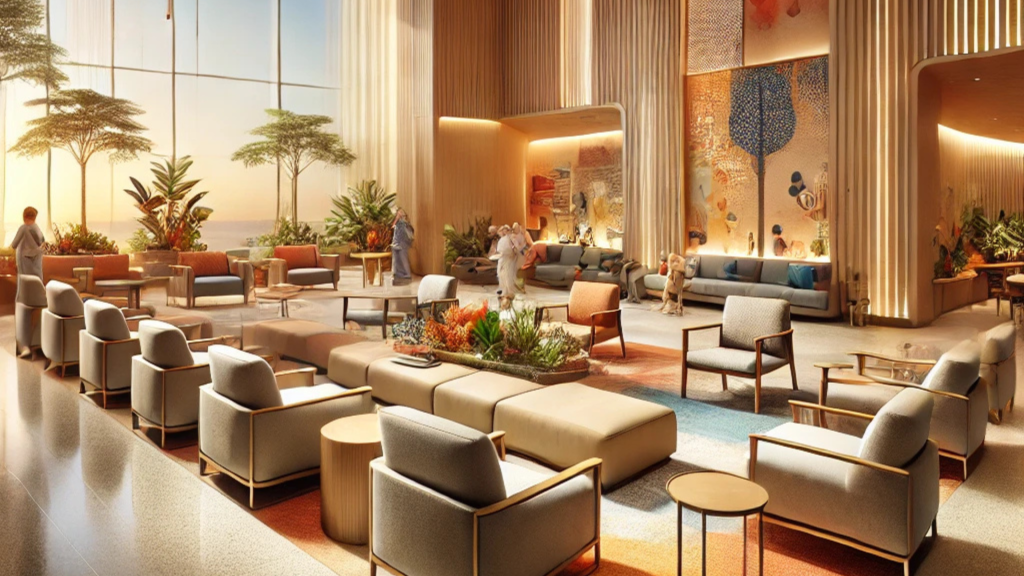
As we look ahead to 2025, emotional well-being is poised to become one of the top priorities in healthcare design. While functionality and efficiency are always important, the emotional comfort of patients, families, and staff will increasingly shape the design of healthcare interiors. A growing recognition of the psychological impact of hospital environments has led to a shift toward creating spaces that promote trust, safety, and comfort.
Healthcare facilities are no longer just places where medical treatments are administered—they are environments that can either enhance or hinder the healing process. By focusing on emotional comfort through thoughtful spatial design, we can create spaces that not only support patients physically but also address their emotional and psychological needs. Below, we explore key design elements that will define the healthcare spaces of the future, helping to create healing environments that foster trust, ease, and a sense of well-being.
Design Elements for Emotional Comfort
Warm and Familiar Materials: One of the simplest yet most effective ways to create a comforting atmosphere in healthcare spaces is through the use of materials that feel familiar and inviting. Wood, natural fabrics, and other tactile materials can create a sense of warmth and security. Natural textures have been shown to evoke a sense of calm, which is especially important for patients who may be dealing with anxiety, fear, or uncertainty. In a healthcare setting, incorporating wood paneling, soft textiles, and materials that mimic the feel of home can make a world of difference. These elements help reduce the clinical, often sterile, feel of hospitals, turning spaces into places of solace and comfort.
Cultural Sensitivity: Emotional well-being is deeply tied to cultural and personal identity, which is why cultural sensitivity must be an integral part of healthcare design. Every patient comes from a different background, and their emotional needs may vary based on their cultural beliefs and practices. Healthcare interiors can foster a greater sense of security by incorporating prayer rooms, private spaces for personal reflection, and layouts that respect local traditions. For example: designated areas for family gatherings or culturally specific features, such as religious symbols or space for rituals, can help patients and their families feel more at home and supported in their time of need.
Home-Like Settings: One of the most important goals in healthcare design is to reduce the anxiety and stress that often accompany hospital stays. By creating home-like settings, designers can significantly improve the patient experience. Residential-style patient rooms, complete with comfortable furniture, soft lighting, and warm color schemes, have been shown to reduce stress and promote quicker recovery. Patients in familiar, comforting environments are more likely to feel at ease, which can lead to improved mental and physical health outcomes. Designing spaces that reflect the warmth and connection to home can help patients maintain a sense of control and comfort, which is vital in a healthcare setting.
A Healing Environment for Patients and Families: The design of a healthcare facility is not only about the patient but also about their families. Visiting loved ones can be a stressful experience, and providing spaces that feel emotionally supportive can help alleviate some of that stress. Family rooms, private zones for conversations, and calming spaces for reflection can make a world of difference for those who are supporting a patient through illness. By creating environments that consider the emotional well-being of both patients and their families, healthcare facilities can build trust and promote a greater sense of safety and comfort.
Looking Ahead – Creating Spaces for Healing: Emotional comfort will be at the forefront of healthcare design for the next 10+ years. The interior spaces of hospitals, clinics, and medical centers will increasingly aim to create environments where patients feel safe, valued, and emotionally supported. Whether it’s through the use of warm materials, culturally sensitive spaces, or home-like patient rooms, healthcare designers will have the power to shape environments that promote trust and healing.
In conclusion, emotional well-being is a critical aspect of overall health, and healthcare spaces must reflect this truth. As healthcare design continues to evolve, creating environments that foster emotional comfort will become a key component of patient-centered care. By focusing on warmth, familiarity, and sensitivity to cultural and personal needs, we can design spaces that not only heal the body but also nurture the mind and spirit. Great design saves lives – let’s create something that makes an impact today……..and for the future! Call me and let’s get started!

